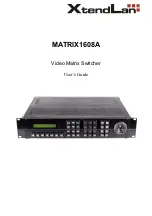
Quick Installation Guide
4
• Power requirements: 100 to 240 VAC (± 10%) at 50 to 60 Hz (± 3Hz). The switch’s
power supply automatically adjusts to the input voltage level.
• The switch should be located in a cool dry place, with at least 10 cm. (4 in.) of space
on the sides for ventilation.
• Place the switch out of direct sunlight, and away from heat sources or areas with a
high amount of electromagnetic interference.
• If you intend to mount the switch in a rack, make sure you have all the necessary
mounting screws, brackets, bolts and nuts, and the right tools.
• Check if network cables and connectors needed for installation are available.
Stacking Switches on a Flat Surface
The Ethernet Switch can be placed
anywhere if there is enough flat space,
such as on a table or desktop.
1.
Stick the self-adhesive rubber foot
pads (that come with this package) on
each of the 4 concave spaces located
on the bottom of the first switch.
2.
Place the first switch on a firm flat surface where you want to install the stack.
3.
Repeat step 1 for each switch before stacking them. The rubber foot pads
cushion the switch against shock/vibrations and provide space between each
switch for ventilation.
Connecting the Switch System
The Ethernet Switch provides 9 RJ-45 ports on the base unit. Each of these ports
supports connection to 10Mbps Ethernet or 100Mbps Fast Ethernet or Giga
Ethernet (Giga uplink port only), and supports full or half-duplex operation. The
transmission speed for each port is automatically set by the switch to match the
highest speed supported by the connected device. The transmission mode can be
set for each port using auto-negotiation .
Making a Connection to an RJ-45 Port
You can use straight-through twisted-pair cable to connect any RJ-45 port on the
switch to any device that uses a standard network interface such as a workstation or
server, or to a network interconnection device such as a bridge or router (depending
on the port type implemented).
1.
Prepare the network devices you wish to network. Make sure you have installed
10BASE-T or 100BASE-TX or 1000BASE-T network interface cards for
connecting to the switch’s RJ-45 station ports.
2.
Prepare straight-through shielded or unshielded twisted-pair cables with RJ-45
plugs at both ends. Use 100-ohm Category 3, 4 or 5 cable for standard 10Mbps
Ethernet connections, or 100-ohm Category 5 cable for 100Mbps Fast Ethernet
connections and Gigabit Ethernet connection.
3.
Connect one end of the cable to the RJ-45 port of the network interface card,




























